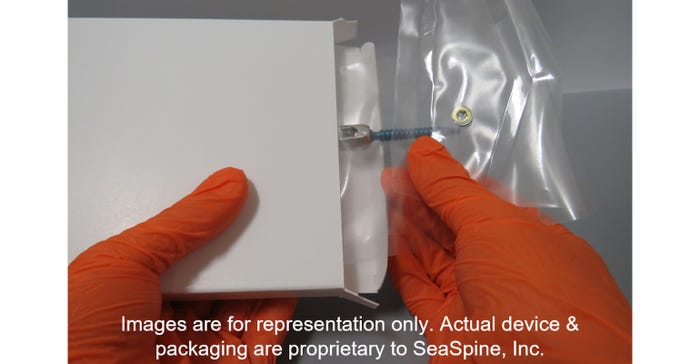SeaSpine’s two-in-one pouch for spinal implants halves sterilization costs, reduces storage space, and maintains the sterility of individual components until the point of use.

Spinal implants are notoriously expensive; however, smaller implants, like set screws, can cost as little as $10 to $50. For SeaSpine, a global medical technology company focused on surgical solutions for the treatment of spinal disorders, packaging set screws in their own package hurt profit margins as the cost of the product equaled the cost of packaging.
To address this as well as other economic and ecological concerns, SeaSpine’s supplier, Oliver Healthcare Packaging, combined two standard chevron pouches by using the same bottom web of materials and inverting the chevron designs inward. The new design, which won a 2022 AmeriStar Award from the Institute of Packaging Professionals (IoPP), allows SeaSpine to combine a set screw with a more expensive product while maintaining the sterile barrier integrity of each implant. Furthermore, the package has cut gamma sterilization costs in half by doubling the amount of product that can fit in a sterilization load.
Efficiency improvements from packing to point of use.
The pouch’s multi-pack configuration means that SeaSpine no longer has to seal, label, and carton two separate pouches at its packaging assembly site. Combining these processes into one step and reducing the amount of materials improves lead times and labor costs.
Because the parts are packaged in separate cavities, there is no risk of damaging the surface treatment on the devices. Additionally, halving the amount of packaging reduces the quantity of non-conformances to handle in the field after distribution.
Now that the package is a folded multipack configuration, resulting in a 50% space reduction, sales reps only have to bring three to five cases of screws into surgery vs. six to 10 cases of individually packaged parts.
Material strength and sustainability gains.
Oliver Healthcare chose biaxially oriented nylon for the pouch because it is compatible with the surface treatment of the spinal implants and robust enough to withstand damage from heavy components that could compromise the sterile barrier. Furthermore, the strength of the two-sided nylon pouch meant that the supplier did not have to use additional materials.
The material allows SeaSpine to package more than 50,000 stock-keeping units (SKUs), thereby avoiding variety and supply chain complexities. The three-web multipack design has also reduced inner pouch material costs by 41.75%, based on current quotations.
In addition to its cost-savings benefits, the package design has positive impacts from a different “eco” perspective: the environment. By combining the sterile barrier products into one package, SeaSpine was able to reduce pouch materials by 25%, as well as shelf cartons and labels by 50%. The shelf cartons for this design are recyclable and may include 30% recycled content.
The pouch itself is also recyclable: Hospitals can send SeaSpine’s nylon flexible packaging to chemical recycling facilities to be converted back to their original polymers and used as “virgin materials” after reaching their end of life.
About the Author(s)
You May Also Like




